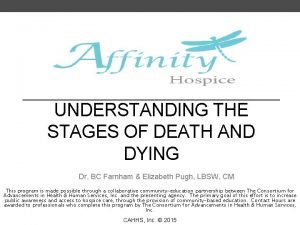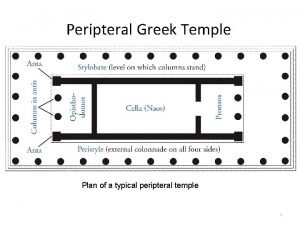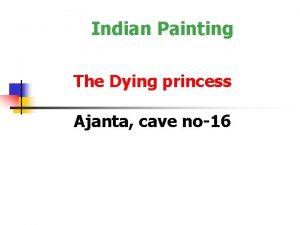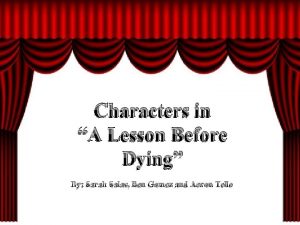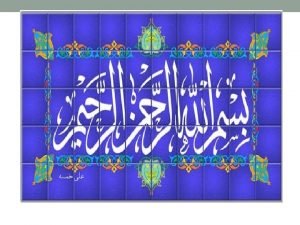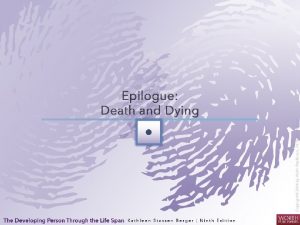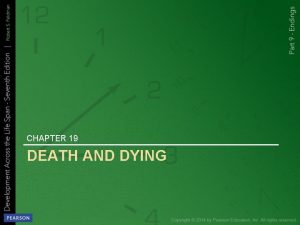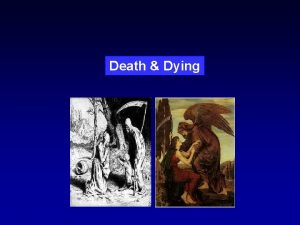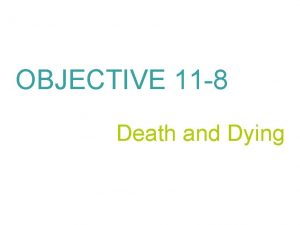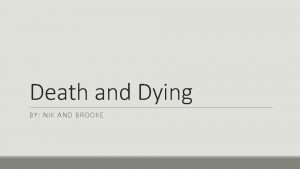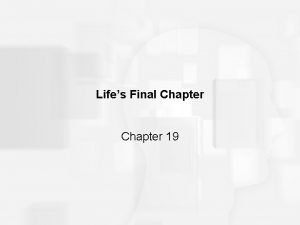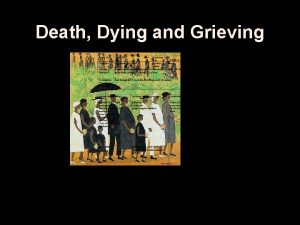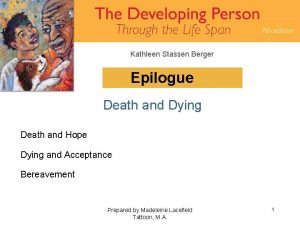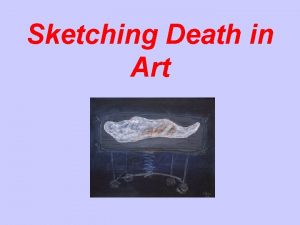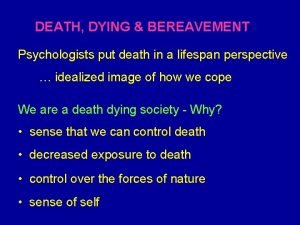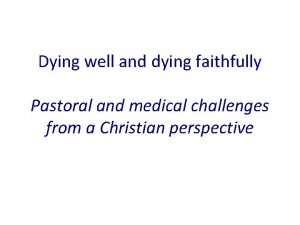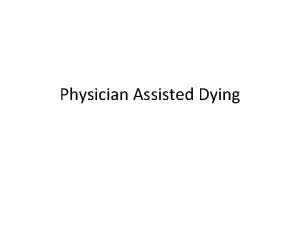Death Dying Thanatology study of death and dying



























- Slides: 27

Death & Dying Thanatology- study of death and dying

Elisabeth Kubler-Ross’s Stages Of Grief 1. Denial 2. Anger 3. Bargaining 4. Depression 5. Acceptance

Stages Of Grieving Identify the stage.

Howard is an architect who has recently been diagnosed with advanced colon cancer. He has recently been hospitalized with pneumonia that developed after his last doses of chemotherapy. The night nurse reports that Howard openly talks about the seriousness of his illness and alludes to the fact he has little time to live. When his family comes to visit, Howard does an about face, chatting sincerely about his plans far into the future.

Denial

Helen has learned that she has an aggressive form of breast cancer. She will required a radical mastectomy, followed by radiation therapy. Her priest came to visit the night before the surgery and found that Helen wanted to talk about the fact that she will no longer be a complete woman.

Depression

The Lion King

Denial

Pat was dying from an oat cell carcinoma that had metastasized to her brain. She drifted in and out of consciousness. When conscious, she would ask for her husband talk to him about her funeral arrangements - what music she wanted, the fact that she wanted to be cremated, and that she only wanted a memorial service.

Acceptance

The Princess Bride

Anger

Margaret had suffered from severe indigestion for over one year. The doctor had prescribed antacids, told her to sleep more upright in bed - using several pillows, and tried several of the medications to decrease acid secretion in the stomach and reduce motility. Nothing seemed to work. After extensive testing, a diagnosis of terminal stomach cancer was rendered. She was overheard saying, “This is so unfair. I have been in such pain for so long and now I’m told I will die. Why has God done this to me? ”

Bargaining

10 Death Rituals From Around The World How do different cultures deal with the grieving process?

Death Across Space And Time • Cultural attitudes on death are revealed through mourning customs. • Defining death is difficult. • Is death always negative?

1. Endocannibalism • Melanesians of Papua New Guinea & Wari people of Brazil • “Feast Of The Dead” • Way to forage permanent connection between living and dead • Expresses loathing, fear, tragedy of death

2. Tibetan Buddhist Celestial Burials • Tibetan Buddhists • “Sky Burials” • Chop up dead bodies • Remains are given to wild birds and other animals. • “Empty vessels” used to sustain other lives

3. Suspended Burials • Bo people of the Hemp Pond Valley in Southwest China's Gongxian County • “Sons Of The Cliffs” • Hanging Coffins • Approx. 300 feet • Paintings depicting lives

4. Sati • India • Ancient Egyptians, Greeks, Goths, and Scythians • Widowed women burned themselves on their husbands’ grave. • Prevent wives from killing husbands? • Together in the afterlife? • Now banned

5. The Viking Funeral • Slave girls would “volunteer” to join to chief in the afterlife. • Sex with every man in the village • Strangled to death with a rope and stabbed • Bodies of the chieftain and slave were placed on a wooden ship that was set alight. • Ensured that the slave girl would serve her master in the afterlife

6. Ritual Finger Amputation • Dani people of West Papua, New Guinea • Gratify and drive away the spirits • Fingers were tied tightly with string and then cut off with an axe. • The leftover piece was then dried and burned to ashes or stored in a special place. • Providing a way to use physical pain as an expression of sorrow and suffering

7. Famadihana • Malagasy people of Madagascar • “Turning Of The Bones” • Process of getting the spirits of the dead into the afterlife • Dig up the remains of relatives and rewrap them in fresh cloth • Dance with the corpses around the tomb to live music

8. Mortuary Totem Poles • American Northwest, Haida People • Body would be crushed to a pulp with clubs to fit into a small wooden box. • Placed on a totem pole • Icons acted as guardians for the spirits' journey to the afterlife.

9. Australian Aboriginal Mortuary Rites • Left to decompose • Liquid from body was rubbed on young men to pass on the qualities of the deceased. • Bones were worn as souvenirs

10. The Zoroastrian Funeral • Believe dead bodies defile everything they touch • Cleanse body with bull urine • “Sagdid”-dog that scares evil spirits • “Tower Of Silence” • Eaten by vultures • Ensures minimal amount of harm to living
 Thanatology ppt
Thanatology ppt Pathological condition
Pathological condition Explain why thanatology is a subfield of psychology
Explain why thanatology is a subfield of psychology Ade firmansyah sugiharto
Ade firmansyah sugiharto An attitude that is helpful in hospice work is
An attitude that is helpful in hospice work is Chapter 13 - death and dying
Chapter 13 - death and dying Taste imagery in the scarlet ibis
Taste imagery in the scarlet ibis Molecular death
Molecular death Method study in management
Method study in management Time study meaning
Time study meaning Differentiate between time study and motion study
Differentiate between time study and motion study Death penalty case study
Death penalty case study Cliff baxter
Cliff baxter Ecological study vs cohort study
Ecological study vs cohort study Retrospective cohort study vs prospective cohort study
Retrospective cohort study vs prospective cohort study Marty lobdell study less study smart
Marty lobdell study less study smart Study to study
Study to study A lesson before dying vocabulary
A lesson before dying vocabulary Stages of dying
Stages of dying Ashly odegard
Ashly odegard The dying rooms
The dying rooms Why we must save dying tongues
Why we must save dying tongues Atypical pneumonia
Atypical pneumonia Thank you lord you died for me
Thank you lord you died for me The fallen warrior of the temple at aphaia
The fallen warrior of the temple at aphaia Dying princess ajanta caves
Dying princess ajanta caves Characters in a lesson before dying
Characters in a lesson before dying Day is dying in the west
Day is dying in the west


















